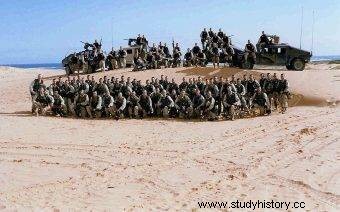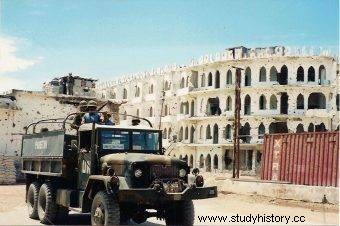The civil war in Somalia continues to this day. Somalis do not recognize the supreme authority, attempts to create and stabilize a central authority since the beginning of the 1990s have failed, and the country eventually plunges into chaos (after all, it is considered a so-called failed state). In this text, we will look at the Battle of Mogadishu, i.e. the clash between UN action troops - UNOSOM II and the Somali National Alliance, which was delivered to mass audiences through a book and film titled "Helicopter on fire".
The military operation became famous thanks to the book by the American journalist Mark Bowden entitled "Black Hawk Down:A Story of Modern War", published in our country as "Helicopter on fire". In addition to the book, most readers may also associate this title with the adaptation of Ridley Scott. This film won, among others two Oscars (for the best sound and editing). A Polish cinematographer, Sławomir Idziak, who was responsible for brilliant cinematography in this film, was also nominated for this prestigious award. But let's focus on history; what was the clash like in real life?
Mohamad Farrah Aidid
In 1969, Mohammed Siad Barre became the dictator of Somalia. His government brutally treated any opposition, and the fights fought impoverished the society. A civil war broke out in Somalia in the early 1990s; power was seized by the United Somali Congress (later the Somali National Alliance) headed by military commander Mohamad Farrah Aidid. After taking power, he questioned the presence of the United Nations and US troops in Somalia, his troops fought bloody battles with the peacekeepers .
UN peacekeeping missions - UNOSOM I, UNOSOM II
In April 1992, the UN Security Council adopted a resolution on the establishment of a peacekeeping mission called UNOSOM I (United Nations Operation in Somalia I). The immediate cause was the outbreak of civil war, Somalia suffered from famine, the International Red Cross tried to organize food supplies, but despite successful ceasefire negotiations, most of the supplies were seized by criminal groups. It was decided to send American soldiers to Somalia (who managed to bring about relative peace, even a provisional government was formed). Famine hit the provinces the most, Somali gangs still operating here, taking over the supplies.
Operation UNOSOM II lasted from March 28, 1993 to March 2, 1995 and was an extension of the UNOSOM I operation. Mohamed Farrah Aidid's armistice terms. In total, 28 countries (over 30,000 people) were involved in the action.

Fiat-Oto Melara Type 6616 armored personnel carrier taken over from the leader Mohamed Farrah Aidid
Battle in Mogadishu
The main task of Task Force Ranger was to destabilize the Habar Gidir clan, whose leader was dictator Mohamad Farrah Aidid. UN troops in Somalia could not cope with quite well-organized clan troops, so the then US President Bill Clinton decided to prepare and send specially selected troops to support the peacekeeping forces. It consisted of:the 75th Ranger Regiment of Fort Benning, sub-units of the Delta Force unit, SOAR regiment, 10th Mountain Division, four SEAL soldiers and orderlies (CSAR). The commander was General William Garrison; an experienced soldier, for example in the Vietnam War (Operation Phoenix).
Action codenamed Gothic Serpent (The Gothic Snake) was an attempt to capture Mohamed Farrah Aidid. To do this, it was first decided to capture two of Aidid's close advisers . The circumstances and the success of the mission depended on it being carried out during the day (and not like the previous TFR actions during the night). The Americans received information about the appearance of targets in one building of the Somali capital - Mogadishu. The whole action was prepared so that it lasted less than 60 minutes ... but lasted several hours longer.
Mark Bowden wrote about Mogadishu as follows:
(...) The city looked as if it had been affected by a terminal disease. The few paved streets, disfigured by a mountain of rubbish, rubble and rusty wrecks of burned cars, gradually turned to ruin (...). Every scrap of free space was covered with the compact buildings of makeshift villages in the form of shacks made of sticks covered with layers of rags and huts made of random pieces of wood and rusted sheet metal. The settlements built by the homeless people, watched from above, resembled a festering ulcer on the city's body .

Bravo Company, 3rd Battalion of the 75th Ranger Regiment in Somalia, 1993
On October 3, in the early afternoon, soldiers could hear the slogan that started the mission - "Irene". Liitle Bird and Black Hawk helicopters took to the air and flew over the target in downtown Mogadishu; a two-story building located on Hawlwadig Road. Little Bird helicopters landed near the target, the soldiers quickly scattered around the key streets. Black Hawk machines were hung over the roof to allow four rangers to descend by ropes to the roof. This is where the trouble started ... Private Todd Blackburn (from a height of 20 meters) unfortunately fell from one of the helicopters . Although some of the soldiers had to cover their colleague and maintain their position, in the end the building was taken over and the targets were taken over.
After Blackburn's accident, a convoy of Humvee armored cars was organized to transport the wounded Private Todd to the hospital (the second convoy was to be used for captured prisoners). The first soldier to die in this action was Dominick Pilla; a bullet hit him in the head while shooting at the attacking Somalis with a rifle in the turret of an armored car.
The first helicopter on fire
Preparations for the departure of the second convoy took quite a long time; continuous fire hampered the organization. Meanwhile, one of Cliff Wolcott's Black Hawk helicopters was shot down; the machine crashed a few streets away from the building that was the target of the mission. In this difficult situation, most of the soldiers were sent to the crash site. The problem was starting to be the multitude of tasks and emergencies . The soldiers got lost in the narrow streets, the convoys could not get out from under the constant fire, communication failed.
At the scene of the crash, Aidida was defended by the wounded colleagues from the fire of the militia, Sergeant Daniel Busch, who was the only one who was able to walk. While defending the damaged machine, he was seriously injured and transported in a Little Bird helicopter (which landed briefly near the crash site) to a hospital in a military base. His life could not be saved; he died as a result of his injuries. To save the rest of the crew, a rescue helicopter with paramedics was sent from the base. Two units of Chalk 1 and Chalk 4 reached the vicinity of the wreckage, the other two were detained in the alleys under heavy fire. The fights to maintain the position at the wreckage continued ...
Second helicopter on fire
Less than half an hour later, a second Black Hawk helicopter flown by Michael Durant was shot down. The aforementioned pilot was the only one to survive the accident. With a broken leg and numerous wounds, he managed to defend his position until two soldiers arrived - R. Shughart and G. Gordon, who volunteered to be able to secure the crash site .

The crew of the Super 64 one month before the Battle of Mogadishu. From left to right:Winn Mahuron, Tommy Field, Bill Cleveland, Ray Frank and Michael Durant
When they got there, they decided to hide the helicopter pilot in a building next to the crash site and repel attacks by Somalis from there. The fights were fierce, it was difficult to hold positions, eventually the overwhelming Aidid militia entered the building (G. Gordon and R. Shughart were shot) and captured him as a pilot captive (after a dozen days he was released).
End of fights
Lieutenant Colonel Danny McKinght's convoy continued to circulate through the city; he was under heavy fire and suffered many losses. Eventually, he managed to get out of the city and drive towards the base. As soon as he crossed the border of the city, all the soldiers sent on this mission were left alone in the city where more and more armed men appeared on the streets.
William Garrison, seeing a hopeless tactical situation, decided to ask for help from the Pakistani UN troops, which were stationed at the city stadium . A new convoy, consisting of armored transporters and tanks, Pakistani and Malaysian forces, the 10th Mountain Division and the remnants of groups fighting in Mogadishu (the new convoy was commanded by Lieutenant Colonel McKnight, who, despite his neck and arm injuries, wanted to return to the city for fighting soldiers).

William Garrison, seeing a hopeless tactical situation, decided to ask for help from the Pakistani UN troops, which were stationed at the city stadium
There was fierce fighting at the site of the first helicopter accident; American soldiers struggled with the lack of ammunition, fatigue and extreme exhaustion, in addition, their positions were fired on with mortars and machine guns by increasing crowds (even civilians reaching for weapons!) . Two hours after midnight on October 4, the convoy reached the lonely soldiers.
Eighteen American soldiers (as well as two Pakistani and Malaysian soldiers) were killed in the fighting, more than 70 were seriously wounded, the losses on the enemy's side are hard to assess, the data is inconsistent (from 300 to 2000 dead). The entire operation was assessed negatively, the US President - Bill Clinton - ordered the withdrawal of troops from Somalia.
